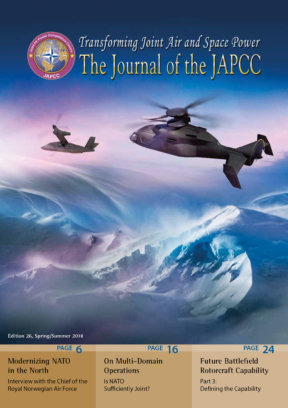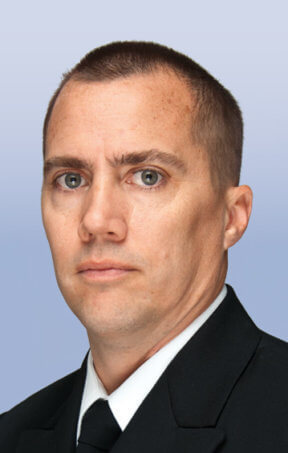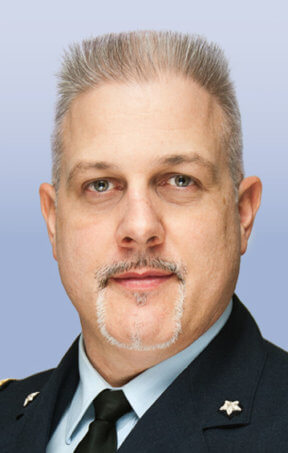Introduction
Recently, there have been multiple think papers, studies and articles proposing a new way of viewing the future battlespace. Many of these treat the entire environment as one single domain or an integrated environment of multiple domains which overlap and are mutually supporting. Sceptics believe Multi-Domain is nothing more than a new paint job applied to the 1980s Air-Land Battle concept, which placed emphasis on the full three-dimensional nature of modern battle and described Maritime, Air, Land and Space based systems working together to defeat an adversary. However, the US Air Force Chief of Staff (CSAF) recently explained it this way: ‘Multi-domain is much more than the ability to work in multiple domains […]. It is also more than operations in one domain supporting or complementing operations in another domain.’1
Following the CSAF’s comments, the Tri-lateral Strategic Steering Group (TSSG) comprising the US, UK, and France, investigated the concept of Multi-Domain Warfare.2 Believing that future adversaries will blend conventional, asymmetric and hybrid capabilities across each of the traditional physical domains (Air, Land And Maritime) plus Cyber and Space, they postulate that a more comprehensive approach to dealing with this security threat is needed to operate in this type of ‘multi-domain environment’. Furthermore, they assert that not only is this multi-domain operations concept a potential for the future but that elements of it already exist within the US, British and French national perspectives on warfare today.
This characterization of the future battlespace begs intriguing questions: Is the Alliance operating today at a level which supports exploration of multi-domain operations? Perhaps more apropos, is NATO today as Joint as it can be, or should be, to support planning milestones toward multi-domain (beyond today’s vision of joint)? Are individual Nations? Before any of us can even begin a serious discussion of MDC2, a look in the mirror regarding today’s realistic level of Joint capability is warranted.
C2 Maturity Levels: From Joint to Multi-Domain
Allied Joint Doctrine for the Conduct of Operations, AJP 3 (B), refers to a Joint operation as one which endeavours to synchronize the employment and integration of the capabilities provided by Land, Maritime, Air, Space, Cyberspace, Special Operations and other functional forces. Therefore an understanding of the capabilities and limitations of each Component in a Joint Force is crucial to achieving ‘Jointness’.3 A fundamental principle of Joint warfare is the recognition and acceptance of separate domains in which operations are principally led by one Service/Component. These domains are ‘Joint’ when capabilities within one component overlap with and are exploited to influence another domain. Therefore, not only can advances in one Component’s particular domain be made by leveraging some of another Component’s capabilities, but in fact, assistance may be required from outside one Component to achieve success within that Component’s specific domain. So, are we currently deeply synchronized at a Joint level and ready to transition to Multi-domain? To answer that question we have to understand where we want to go.
To arrive at the assessment of the future battlespace environment, the JAPCC’s ‘Air Warfare Communication in a Networked Environment (AWCNE)’ study reviewed the conclusions in the Joint US DoD Command and Control Research Program and the NATO System Analysis and Studies (SAS-065) which outlined levels of C2 maturity. Based on Alberts et alia’s ‘Maturity Model’4 and a review of NATO’s recent operations and exercises, the authors concluded that while Collaborative and/or Edge C2 is the goal within NATO, the ‘level of C2 maturity in the Alliance today can best be described as only functioning between the De-conflicted and Coordinated levels’. In other words the Alliance conducts operations where Service/Component missions are segregated or at best partially coordinated for mutual effect rather than being fully synchronized (which would meet the criteria of ‘collaborative C2’ as outlined in the NEC model). This is significant in that a truly Multi-domain C2 capability would require at least Collaborative, if not Edge C2.
The C2 maturity assessment is based, most significantly, on differences in the technology of platforms and software which do not interface seamlessly. As an example of some of these challenges within NATO, the Bi-SC Air-Maritime Coordination Working Group (AMCWG) has been investigating for years the challenges to the exchange of the Recognized Air Picture between ships at sea and Combined Air Operation Centres (CAOCs) ashore, which is currently inhibited by both technical interface issues and Alliance policy issues (accreditation).5 Another example which is restricting NATO’s C2 maturity is that not all NATO Nations’ aircraft are Link-16 capable, restricting where, when and how these aircraft may be employed in the Joint fight. Consequently, the Alliance has some significant technical, procedural and policy challenges to overcome before realistic advancement in its C2 maturity can occur.
Lessons Identified from Recent NATO Joint Operations and Exercises
The 2014 NATO Summit Communique (Wales) stated that NATO nations ‘will ensure that their Armed Forces can operate together effectively, including through the implementation of agreed NATO standards and doctrines’. However, there is recognition within the Alliance that we are not meeting our own defined expectations.6 Although ‘operating together’ is more about ensuring interoperability of forces during multinational operations, it is implicit within the verbiage that NATO must ensure it operates jointly as well as multinationally.
Why is this happening? One of the reasons is that we have endemically shunned the Joint perspective. For example, in 2010 the NATO liaison program, which provided standing liaison capability between the Single Service Command (SSC) Headquarters (HQs), was dis-established with a vision of ‘virtual integration’. The functions each liaison element performed in daily staff meetings or in supporting planning efforts would, theoretically, then be conducted via distance support from each respective home HQ. During ’actual‘ operations, these liaison cells are formally established per NATO doctrine, but the standing, day-to-day liaison functions have largely atrophied as the personnel to perform them are no longer available. For example, Allied Air Command (AIRCOM) and Allied Maritime Command (MARCOM) are both executing STANDING day to day operations without these liaison elements. This has resulted in SSCs compartmentalizing day to day operations planning and has exacerbated poor integration of planning efforts leading into major exercises, as well as perpetuating a lack of knowledge about the capabilities and limitations resident within each of the sister-components. Significant lessons identified show that the Alliance is challenged even when executing the basic tenets of Joint warfare, never mind being postured to take a leap into a battlespace requiring a higher level of interoperability.
The JAPCC, along with NATO’s Maritime Air (MARAIR) Commander, co-chairs the annual Bi-SC Maritime Air Coordination Conference (MACC), a forum specifically created to address coordination issues between air and maritime components. In 2017, MARCOM and AIRCOM drafted and submitted to SACEUR a white paper outlining the five most pressing integration issues, binned into Personnel, Procedures and Technical Issues categories, which have been ‘in work’ for over a decade with little headway made.
A second product of the 2017 MACC was the development by the JAPCC of a briefing entitled ‘Component Integration Challenges stemming from Advanced Layered Defense Systems (A2/AD)’, expanded beyond just air and maritime to the entire Joint force. The JAPCC, together with experts from the NATO CAOC in Uedem, Germany, and Naval Striking and Support Forces NATO (STRKFORNATO), developed this comprehensive overview based on more than five years of observations on Joint integration in NATO exercises since 2010, with a specific eye toward identifying improvements necessary to succeed in operations against a near-peer adversary. This roadshow briefing has been presented to Joint Force Commands (JFCs) Brunssum and Naples, MARCOM, AIRCOM, STRKFORNATO, NATO Special Operations Headquarters (NSHQ), the Joint Warfare Centre (JWC) and the Senior Mentors for exercise Trident Javelin 2017.7
Efforts have been made in the last five years to provide rigour to the ‘Trident’ exercise series, however, a few observations may encapsulate the level of Joint warfare which the Alliance is capable of operating at today, and shed light on the challenge in moving forward toward a multi-domain concept.
Overall, training audiences in NATO’s exercise program often struggle with Joint Operations, both in planning and execution. During the Road to War preparation for exercise Trident Javelin 2017, each of the Components and the JFC HQ conducted Battle Staff Training and operational planning separately, not only in different locations but at different times. This resulted in three separate mini-campaigns (Air, Maritime and Land) rather than a synchronized set of single-Component activities choreographed to achieve effect. This notable lack of Joint coordination at the operational level (JFC) is not an isolated occurrence and results in a lack of coherent operational design. This manifests in a few ways:
First, many staffs are not interested in the Joint fight in exercises, rather there is a tendency for the operational level to be enamoured with the Land battle and expect Maritime and Air operations to serve only as enablers to achieve the Land fight. For this reason, NATO rarely exercises Day Zero, but rather hits the fast-forward button to accelerate further into the campaign so that the Land fight becomes the predominant focus of activities during the execution phase. The final result of this is to skip the hard Joint integration issues necessary to ‘fight to get to the fight’.
Secondly, NATO training audiences sometimes fail to follow NATO doctrine in exercises, most notably in Air Defence (AD). Based on observations in many different exercises, it is the authors’ opinion that none of the Components fully understand our AD doctrine. This is reflected in a lack of awareness between the Maritime and Air components staffs about terms such as Combined Air Sea Procedures (CASP)8 which define the Tactical Control (TACON) relationship between the Air and Maritime component of the AD capable ships, and is further manifested by friction between the Land and Air component about the location, use and control over advanced AD systems (such as Patriot) which are frequently miss-classified as Army Organic AD, contrary to NATO doctrine.
Third, there remains a persistent belief that NATO will have full clarity of the battlespace in all future operations. This belief is founded upon the reliance on Intelligence, Surveillance, Reconnaissance (ISR), specifically imagery, and a lack of understanding of the electromagnetic environment, which will in many cases be degraded or denied by an adversary. In the most challenging exercise scenarios, NATO’s intelligence collection capability is significantly impacted by adversary countermeasures, which necessitates a more thorough analysis at the Joint level not only to integrate and fuse collection methods to generate a picture but requires a more detailed and rigorous analysis of the Joint targeting process itself to maximize effect. However, many training audiences baulk at any scenario in which degradation to intelligence collection is imposed. This speaks to an underlying lack of awareness, or lack of appreciation, of adversary capabilities. The lesson NATO needs to take forward from this is to improve not only our analysis of adversaries and the environment but to more thoroughly integrate Joint collection capabilities to counter the effects of service degradation better and to improve the Joint targeting process.
Finally, the exercise structure itself struggles when juxtaposed against the requirement to generate qualified forces/staffs to achieve NATO’s stated Level of Ambition.9 The set of certification exercises require that forces achieve certification and frequently have only a limited opportunity to address or correct significant shortfall areas. Often, results are ‘doctored’ not only to ensure certification but also to assuage the cultural conditioning of many staffs to ‘only look good, never be challenged or fail’ in exercises. Rather than embracing a fail-assess-adapt-improve process for exercises, many staffs and training audiences expect certification just for showing up, espousing a pervasive belief in the infallibility of NATO weapons systems and a disregard for peer adversary capabilities.
How Can NATO Improve its Jointness?
One of the challenges experienced by Member Nations of the Alliance spans both national and NATO chains of command. Officers and senior-NCOs are frequently not exposed to Joint operations, nor have they completed requisite Joint training, until well into their careers. It is not uncommon for an officer to be serving their first tour of duty in a Joint assignment at the OF-4 (Lieutenant Colonel or equivalent) paygrade. It is this level of experience which is the major muscle behind the development of operational plans, and those same officers, through no fault of their own, bring service and national ‘bias’ to their planning due to a lack of knowledge or experience with other elements of the Joint force.
To address this lack of ‘Jointness’ the TSSG proposed the creation of a specific career path devoted to developing operational level staff to not only fight jointly but to understand how to employ the spectrum of Joint capabilities across a multi-domain environment.10 Similarly, ‘The (US) Air Force will work to build a C2 workforce cadre of officers to engrain the expertise and proficiency at a career level rather than see personnel cycle in and out on short-term rotations’.11
While an interesting concept, this idea is contrary to what some authorities espouse. That is, a future operational level staff (Joint) must be comprised of experts in each of the single service capabilities, and that is not something that comes from the classroom, rather it takes years of tactical/tactical-operational level experience to develop. So, what can be done to create more highly capable Joint officers while keeping a balance with their parent Service’s core competencies?
To improve its ‘Jointness’, and to improve the effective use of air power in a Joint environment as the first step toward multi-domain operations, NATO must be able to address two questions:
- How is NATO currently training air component commanders to plan air campaigns and to plan the Air Power contribution to a Joint campaign?
- What needs to be done to tailor any existing training/exercises to better prepare commanders to plan for, and exercise, Air Power in Joint campaigns?
Currently, the training curriculum at the NATO School in Oberammergau offers two courses to address Joint operations. The Comprehensive Operations Planning Course aims to educate military officers (from Major to Colonel or equivalent) to contribute to NATO’s operations planning process either as a Joint operational-level or functional-area planner while applying the principles of the Comprehensive Operations Planning Directive (COPD).12 Second, the Strategic Operational Planning Course teaches how to apply the COPD within the framework of the Comprehensive Approach and is directed at NATO and partner officers (military from Major to Colonel, or civilian equivalent) working primarily in the Strategic NATO Headquarters or more generally in an assignment related to strategic level planning.13 Furthermore, for airmen, the Deployable Air Command and Control Centre (DACCC) in Poggio Renatico (Italy) offers a course for Joint Air Operations planning that focuses on the tactical employment of air assets within a Joint campaign, i.e. with some but limited attention on operational-level effects-based and comprehensive planning. All of these courses, however, are relatively new to the NATO lexicon and although they appear to hit the mark, the annual throughput is rather low for a variety of reasons.
Conclusion
Any movement towards multi-domain must begin with changes in how we develop our personnel. As this ‘MDC2 career concept’ takes further form, for it to succeed it must ensure our personnel are truly Joint-trained and Joint-minded, while retaining the expertise in Component capabilities that allow them the be ‘expert’ in the first place. This requires exposure to the full spectrum of Joint capabilities in both educational and operational settings, earlier in the career, and perhaps the opportunity to serve longer to spend more time in the Joint environment prior to assuming planning and eventually leadership roles in a Joint Force or future MDC2 environment.
Also, today’s operations and exercises demonstrate that NATO is mired at the De-conflicted level of C2 maturity, and has a long way to go before it is truly capable of Joint operations at the Collaborative level. This is significant in that the Collaborative level of C2 maturity in Alberts et alia’s model is required before any meaningful discussion can occur regarding Multi-Domain operations. To get there, C2 system interfaces must evolve beyond their current capability and roadblocks to sharing must be removed. As expressed by General Goldfein, ‘if the Air Force wants to build a single global network linking Forces in the Air, Sea, Land, Space, and Cyberspace, it must first eliminate the proprietary standards that keep its existing systems from sharing data.’14 In reality, this may be beyond the scope of today’s systems.
Many of the challenges identified in this article are widely known but not publicly acknowledged outside of meetings between frustrated staff officers. Ultimately, until we are willing to have some uncomfortable conversations about our current level of ‘Jointness’, Multi-domain will remain a worthy, but unreachable goal.













